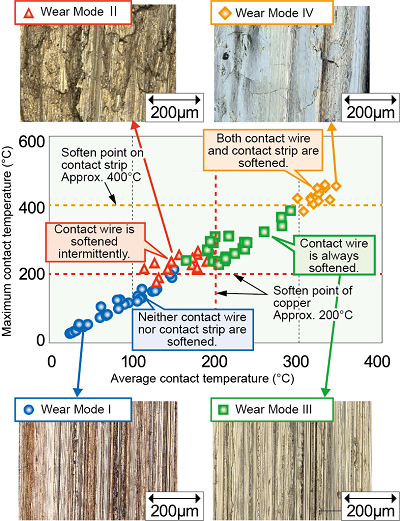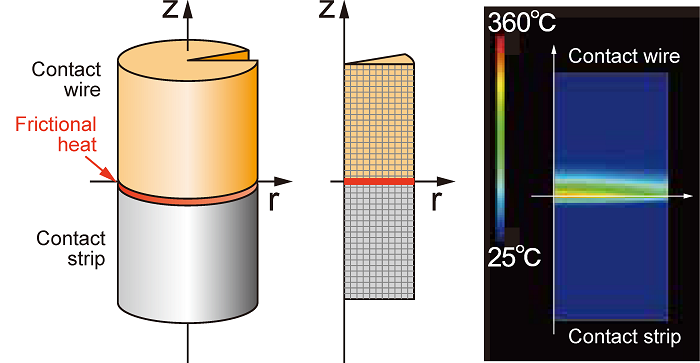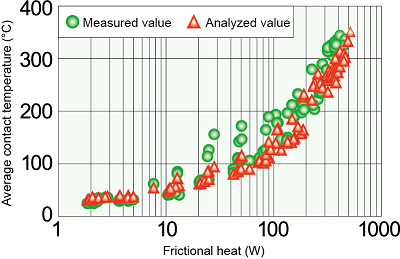27. Clarification of wear mechanism of current collecting materials caused by frictional heat
Current collecting materials such as contact wires and pantograph contact strips are subject to wear due to various factors such as contact force, running speed and current. The effect of Joule heat by current has already been made clear, but the mechanical wear mechanism caused by sliding has not been fully clarified.
Therefore, we have developed a new wear-testing machine that can measure the contact temperature between the copper plate and the contact strip during sliding and investigated the relationship between the contact temperature and the wear mode caused by frictional heat. As a result, we found that there were four modes of mechanical wear depending on the maximum and average temperatures, and that the softening of the material due to the temperature was an important factor in the transition of the wear mode (Fig. 1). In particular, we confirmed that the surface of the contact wire was significantly worn, like delamination in wear form II, which is considered to be the cause of significant wear of the contact wire in low-speed sections where the frictional heat is small and the average contact temperature does not rise.
Furthermore, we constructed a numerical analysis model (Fig. 2) that could calculate the temperature rise at the contact point by inputting the frictional heat as heat flux to the contact area, and confirmed by simulation that the measured average temperature of the contact point was consistent with the analyzed value (Fig. 3). In the future, we plan to facilitate the technology development to reduce the maintenance cost of current collecting materials, by integrating this analysis with the analysis of temperature rise due to Joule heat that we have developed so far, to develop a method for predicting the wear mode that will occur in the actual field, and to propose measures to control wear by controlling the wear modes.
Other Contents
- 22. Numerical simulation of ventilation in a vehicle by opening windows while running
- 23. Analytical evaluation method for the speed at which hunting occurs
- 24. Evaluation of the influence of wheel machining marks on the friction coefficient by visualizing the contact area
- 25. Wheel slide protection simulator to supplement on-track testing
- 26. Non-contact method to detect rail openings using aerial ultrasonic waves
- 27. Clarification of wear mechanism of current collecting materials caused by frictional heat
- 28. Method to evaluate physical properties of frictional materials by numerical simulation
- 29. Detection of changes in drivers' physical and mental state using physiological indicators
- 22. Numerical simulation of ventilation in a vehicle by opening windows while running
- 23. Analytical evaluation method for the speed at which hunting occurs
- 24. Evaluation of the influence of wheel machining marks on the friction coefficient by visualizing the contact area
- 25. Wheel slide protection simulator to supplement on-track testing
- 26. Non-contact method to detect rail openings using aerial ultrasonic waves
- 27. Clarification of wear mechanism of current collecting materials caused by frictional heat
- 28. Method to evaluate physical properties of frictional materials by numerical simulation
- 29. Detection of changes in drivers' physical and mental state using physiological indicators



